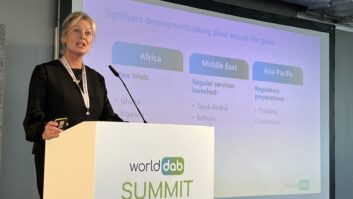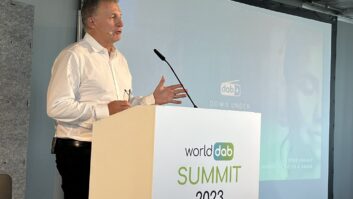
With more than 50 million DAB receivers sold worldwide, DAB/DAB+ digital radio standard is now established in several countries including Norway, United Kingdom, Netherlands, Denmark, Germany, Switzerland, Slovenia and Italy, and developing in Poland, Belgium and France.
In advanced markets such as Norway a DAB+ receiver is provided as standard in 98 percent of new cars, 88 percent in the U.K and 66 percent in Switzerland.
During the WorldDAB session at IBC2017, Patrick Hannon, WorldDAB president, highlighted the above figures in his keynote speech, while reconfirming the request to European Union authorities to stop the sale of analog-only radio receivers in Europe.
Graham Dixon, head of radio at the European Broadcasting Union, stressed the importance of a universal, self-standing radio distribution system capable of providing information, even during disasters. He pointed out that over the years terrestrial radio broadcasting has proved its resilience in times of adversity, often being the only medium able to reach those affected with life-saving information and general updates.
The necessity to join efforts of public service- and commercial broadcasters to successfully deploy digital radio stood out during a joint speech given by Jon Branas, acting director of Norwegian state broadcast NRK Radio and Kenneth Andersen, director of Radio at leading national private station P4 Radio.
In their presentation, Branas and Andersen confirmed how the country’s commercial and public service broadcasters contributed to the planning and development of the FM switch-off process with the common goal of deploying proper coverage, widening the public proposition of free-to-air radio channels and running widespread communication campaigns to the benefit of listeners through any available medium.
“We were able to take advantage of the wide audience reach of NRK television channels,” said Andersen. They aired a number of ads promoting digital radio’s offering, not only their own radio channels. For the very first time, we saw messages on NRK promoting commercial station listening.”
Radio stakeholders in Norway agreed that, as part of the process, NRK would switch off its FM channels a couple months before the commercial broadcasters. The idea was that the sudden unavailability of the very popular NRK channels would have driven late-riser consumers to source the DAB receivers they were still missing. This way, commercial broadcasters switching two months later could have rely on almost the same potential audience they could with FM.
On Sept. 20, NRK is switching off its FM transmitters in the region of Oslo, meaning that 96 percent of the population will be able to receive NRK channels only via DAB. Even if radio consumption in Norway has been decreasing for several years, aggregated audience data shows that the switchover process, which could have pushed audiences to move to other platforms, has not caused this to happen, testifying to the effective deployment of digital radio in Norway.












